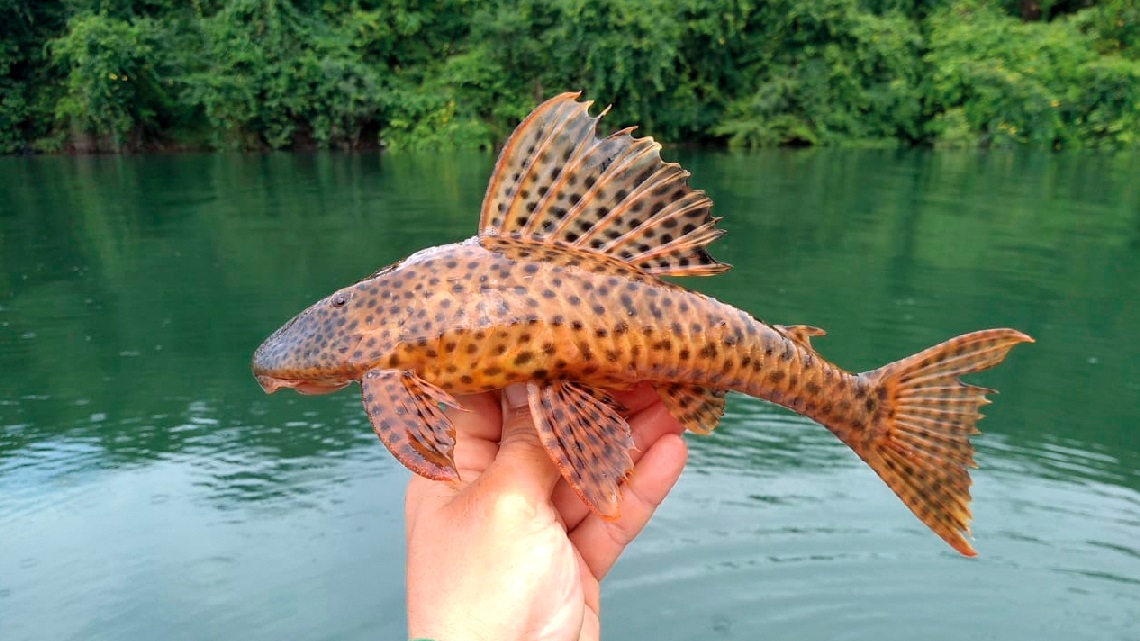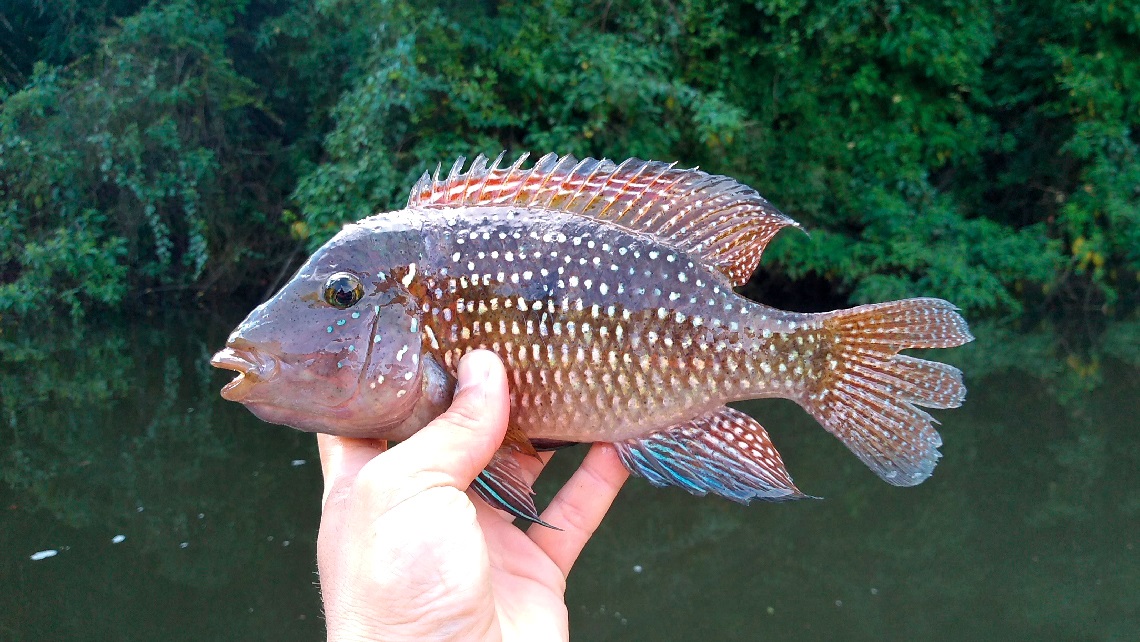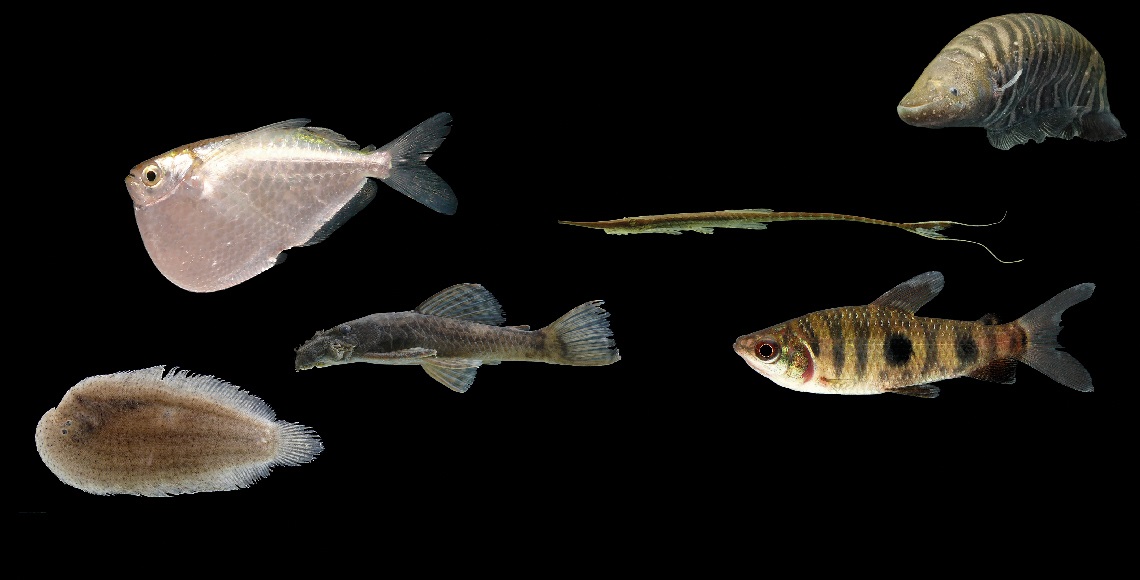From arowanas and vampire fish to streaked prochilods and catfish. And from dorados, tetras, soles, and red-tailed Brycon to piranhas, surubims, tambaquis, banded knifefish, and triangle cichlids. With one of the vastest river networks in the world, South America is home to a staggering variety of freshwater fish, with enough species to list several for each letter of the alphabet. With approximately 5,800 known species, accounting for slightly over one-third of the total known species worldwide, and an estimated 3,000 yet to be discovered, the region’s rivers, streams, lakes, and temporary lagoons are teeming with fish exhibiting an incredible array of shapes, colors, and sizes: from the tiny Priocharax nanus—a slender, almost transparent fish measuring only 1.5 centimeters in length—to the colossal Arapaima gigas, or pirarucu, reaching up to 3 meters in length, adorned with a red tail and covered in thumb-sized scales forming an armor against predators. This unparalleled diversity, the highest in the world, has long puzzled scientists, prompting the question: why are there so many fish species in South America?
A comprehensive explanation was recently unveiled in a January article in PNAS. Geological phenomena over the past 55 million years have triggered at least five major rearrangements of South American river basins, leading to significant bursts of new species formation, with a low rate of extinction. These landscape transformations, occurring over long intervals of time, have produced two main effects. In some areas, they have connected previously separated river and lake systems, resulting in different species being intermingled. For example, between 33 million and 23 million years ago, a valley emerged that connected the Paraná River basin with some rivers along the Brazilian coast. In other areas, the recontoured landscape created barriers that blocked fish migration, isolating populations and leading to separate evolutionary pathways and the formation of new species. This can be seen, for example, in the Amazon, where the formation of the Púrus Arch approximately 20 million years ago separated the eastern and western portions of the river basin.
A groundbreaking study led by Brazilian ecologist Fernanda Cassemiro from the Federal University of Goiás (UFG), in collaboration with 20 researchers from institutions in Brazil and abroad, has recently confirmed the century-old hypothesis that landscape remodeling played a crucial role in shaping the current diversity of South American fish. They analyzed distribution data and the diversification patterns of current species and compared them with the main geological events on the continent in the last 100 million years. “We observed that species concentration patterns and the occurrence of endemic species are strongly associated with the timing and location of specific landscape alterations,” says Cassemiro, the lead author of the PNAS article. “Previous studies had not been as comprehensive.”
The researchers first compiled 306,000 records of the occurrence of 4,967 freshwater fish species in 490 river basins in South America (see map). They reconstructed the evolutionary history of 3,169 species for which there was information available in GenBank, the largest international database of DNA sequences. This evolutionary history was then represented in a phylogenetic tree, a graphical representation that illustrates the degree of relatedness between species and provides insights into when species diverged from each other. This data was then fed into a mathematical model to determine whether the major bursts of species formation and extinction coincided in time with geological phenomena that caused significant changes in the river network.

“This is certainly one of the broadest studies on the distribution and evolution of neotropical fish. Its analysis of information from such a large number of species is unprecedented,” says ichthyologist Alexandre Cunha Ribeiro from the Federal University of Mato Grosso, who was not involved in the study. “The history of South American river basins, however, is complex, and any direct association between landscape evolution events and their consequences for biota diversification should be regarded as a hypothesis to be either corroborated or refuted,” he explains.
Naercio Menezes, an ichthyologist specializing in neotropical fish and a senior researcher at the Museum of Zoology at the University of São Paulo (USP), believes the new study will have significant impact as the first to reconstruct the distribution, origin, and dispersal of fish species using genetic data from a global database. However, Menezes expresses concern about the quality of the data uploaded by other researchers, noting that “the analysis would be more robust if the authors had confirmed whether the specimens used to construct the phylogenetic tree had been correctly identified by checking collections in universities and museums.”
In the PNAS study, the researchers initially hypothesized that rates of speciation and extinction would be chronologically linked to major geological events. If this were true, the mathematical model they used would be expected to reveal abrupt changes in the rates of species emergence and extinction concurrently with the landscape changes. “When we compared the model results with the dates and locations of the geological events, the fit was perfect,” reports Thiago Rangel, an ecologist at UFG and a coauthor of the study. “We obtained compelling evidence supporting the idea proposed by naturalists such as Alexander von Humboldt [1769–1859] and Alfred Wallace [1823–1913] that geological events influenced the emergence and extinction of species.”

Augusto Frota / Universidade Estadual de Maringá A specimen of Hypostomus myersi (armored catfish) captured in the Iguaçu River basinAugusto Frota / Universidade Estadual de Maringá
Around 100 million years ago, after separating from Africa, the immense rock formation that makes up present-day South America remained under the influence of the oceans for an extended period of time. As the climate warmed and sea levels rose, sometimes reaching 200 meters higher than current levels, the waters advanced hundreds of kilometers inland, occupying lowlands and isolating preexisting river systems. Subsequent cooling of the planet caused the sea water to recede, expanding the coastal plain and allowing for the emergence of new connections between watercourses in these areas. “The ebb and flow of the oceans likely played a significant role in the emergence of new species, particularly along the periphery of the continent,” explains Roberto Reis, an ichthyologist from the Pontifical Catholic University of Rio Grande do Sul (PUC-RS) and a coauthor of the research.
Approximately 55 million years ago, the river network of a vast area in northern South America, which is now occupied by the present-day Amazon basin and the Orinoco River basin, formed a single system of rivers that remained interconnected until 33 million years ago. This included connections to the Paraná River basin in the south-central part of the continent. Millions of years later, the collision between the South American tectonic plate and the Nazca Plate in the Pacific caused deformations in Earth’s crust, resulting in the uplifting of the central portion of the Andes mountain range. This uplift gave rise to the high Andean plateau extending through Bolivia and parts of Peru, and a barrier known as the Michicola Arch near northern Argentina. These formations blocked the connections that existed between the watercourses of the western Amazon and the Paraná River basin, which have since communicated with each other only intermittently during flood events.
Almost at the same time, crustal stretching created a valley extending from southern to southeastern Brazil that connected the rivers of the Paraná River basin with those of the Atlantic coastal plain. This connection was interrupted between 23 million and 16 million years ago by the uplifting of the Serra do Mar and Serra da Mantiqueira mountain ranges. As a result, a unique pocket of endemic species emerged in the Paraíba do Sul and Ribeira de Iguape river basins, second only in quantity to the Western Amazon.

Augusto Frota / Universidade Estadual de Maringá Geophagus iporangensis (acará-iporanga) specimen from the South Atlantic basinAugusto Frota / Universidade Estadual de Maringá
Around the time when these mountain ranges emerged, another significant transformation occurred in the northern part of the continent. Crustal movements and lava eruptions uplifted the terrain near the course of the Purus River, west of Manaus, splitting the Amazon basin in two. Its waters, which previously flowed towards the Pacific, took two separate courses. The rivers on the eastern side began flowing into the Atlantic, while the waters on the western side became trapped in an enormous wetland, known as the Pebas lake or system (see Pesquisa FAPESP issue nº 125). Around 16 million years ago, the uplifting of the northern portion of the Andes, between Peru and Venezuela, and the buildup of sediments in the basins to the east of the mountain range forced the rivers to flow east. About 10 million years ago, they breached the Purus Ach, creating the Amazon River.
These landscape rearrangements led to a diversification of fish species that was heterogeneous in time and space. Phylogenetic tree analysis identified at least five abrupt changes in the rate of emergence of new species: two of them between 30 million and 23 million years ago, when the La Plata River basin disconnected from the Amazon and connected to the rivers of the Atlantic coast; and three between 20 million and 7 million years ago, during the recent transformations in the Amazon basin. The changes in species formation rates were driven by three lineages of regular catfish—a fish species with leathery skin and feelers (barbels) around the mouth—as well as armored catfish, a species with bony plates covering its body. These shifts in diversification rates occurred primarily after the Michicola Arch separated the west Amazon drainage basin from the La Plata River basin.
According to Reis from PUC-RS, South America currently boasts a megadiversity of fish due to a combination of favorable geological dynamics that led to the emergence of a wide variety of species, as well as relatively low levels of extinction resulting from climatic factors. “Unlike tropical regions in Africa and Australia, there were no large deserts formed in South America. Furthermore, the region did not undergo glaciations as severe as those that occurred in Europe and North America,” explains Reis.
In the current study, Cassemiro and her colleagues identified at least 3,730 fish dispersal events across South America. Nearly half (45%) of these events originated from the eastern and western portions of the Amazon, particularly in the last 23 million years. Species from the Western Amazon, a region with particularly high endemism, enriched the La Plata River basin primarily, with three distinct migration peaks occurring between 30 million and 10 million years ago. Over the past 20 million years, the La Plata River basin, which is formed by the Paraguay and Paraná rivers and their tributaries, also received a significant proportion of its species from the rivers of the Atlantic coast, to which it remained partially connected even after the rise of the Serra do Mar and Mantiqueira mountain ranges. Species dispersal from the Eastern Amazon trended primarily toward the river network in Guiana and, more recently, after the formation of the Amazon River, to the western portion of the Amazon basin.
“The findings of the study indicate that the shifts in species diversification rates occurred prior to the uplift of the northern Andes and were not confined to the Amazon basin,” says Rangel from UFG. Ribeiro from UFMT adds that “the research reinforces the notion that the South American continent harbors an ancient freshwater fauna whose diversity has built up over millions of years.”
Scientific article
CASSEMIRO, F. A. S. et al. Landscape dynamics and diversification of the megadiverse South American freshwater fish fauna. PNAS. Jan. 3, 2023.


